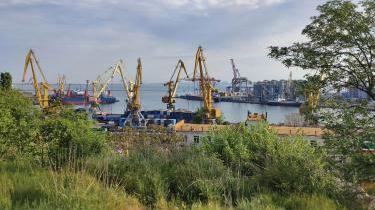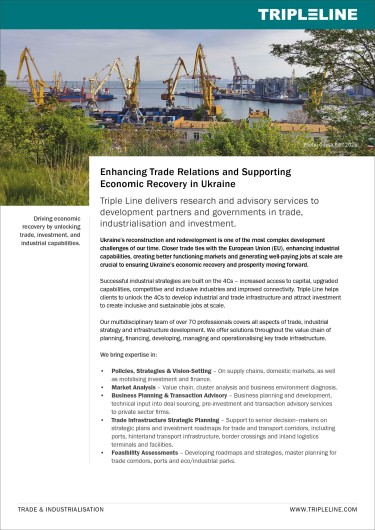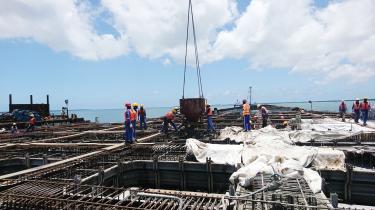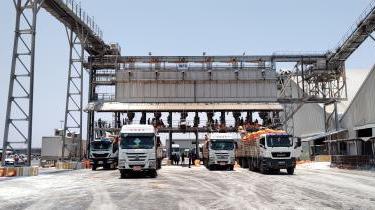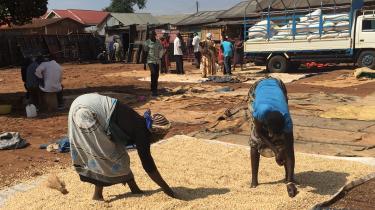Rebuilding Ukraine's trade and industry is one of the defining development challenges of our time. Recovery is more than repairing physical assets; it is about creating livelihoods, driving sustainable growth, and building lasting prosperity.
Beyond the immediate need to repair damaged infrastructure, Ukraine faces the longer-term task of building an economy that can generate jobs, attract investment, and integrate more deeply with European and global markets.
The path ahead is not straightforward. Ukraine's recovery requires more than financial resources — it demands new strategies for trade, industrialisation, and infrastructure development that will shape its competitiveness for decades to come.
The economic challenge ahead
Ukraine's future prosperity rests on several interlocking priorities:
- EU accession and integration – aligning institutions, policies, and business practices with European standards.
- Industrial competitiveness – building capabilities that can generate higher-value production and inclusive growth.
- Trade infrastructure – modernising corridors, ports, and logistics to connect producers with markets.
- Job creation at scale – ensuring recovery provides secure and sustainable livelihoods.
- Climate resilience – embedding low-carbon development into reconstruction from the start.
Each is complex on its own; together, they demand a coordinated, forward-looking strategy focused on the triple imperatives of inclusive economic growth, social development, and environmental protection.
What experience tells us
In our work across regions, we've found it valuable to consider industrial strategies through the lens of the '4Cs': Capital, Capabilities, Competitiveness, and Connectivity. This is not a fixed doctrine, but a practical framework that helps us and our partners make sense of the interdependencies that shape economic transformation.
- Capital – securing investment and finance for large-scale recovery
- Capabilities – strengthening skills, institutions, and productive systems
- Competitiveness – ensuring industries are efficient, inclusive, and globally connected
- Connectivity – building resilient, integrated infrastructure networks
Our work across Africa, Asia, and beyond shows that when these four elements align, countries can transform recovery into long-term growth. For Ukraine, achieving this alignment will be critical to shaping long-term outcomes.
While Ukraine's context is unique, our experiences working in other regions point to challenges and opportunities that will be familiar:
Trade Agreements and EU Alignment:
In supporting countries through WTO accession and bilateral trade negotiations, we've learned that the real test comes after agreements are signed. Translating commitments into functioning systems — customs practices, regulatory bodies, and business compliance — is where progress often stalls. For Ukraine, success will depend on how quickly domestic institutions and firms can adapt to EU standards, rather than just the speed of legislative alignment.
Economic Growth Strategies:
Our work in Ethiopia and Indonesia shows the importance of sequencing reforms. Targeting a few priority value chains can deliver early results, attracting investors and building confidence, while laying the groundwork for broader diversification. Ukraine will face similar decisions about which industries to back first, balancing immediate recovery needs with long-term industrial transformation.
Trade Processes and Customs Efficiency:
In the Horn of Africa, digital platforms and risk-based clearance systems have dramatically reduced border delays. For Ukraine, simplifying customs and harmonising with EU systems is not only a technical necessity for accession — it is a lifeline for exporters who need predictable, efficient routes to market under extraordinary circumstances.
Corridor and Infrastructure Planning:
Infrastructure investments often fail when treated as standalone assets. Our experience shows that ports, inland terminals, and logistics corridors deliver full impact only when planned as integrated systems, with attention to "last-mile" connections to cities and industrial zones. For Ukraine, resilience and redundancy across transport networks will be as much about security as economic efficiency.
Green Economic Development Corridors:
Globally, we've helped governments link corridor investments with climate priorities, unlocking new finance while future-proofing competitiveness. For Ukraine, embedding low-carbon principles into reconstruction could be a double win: strengthening the case for EU integration while positioning its industries to thrive in a decarbonising global economy.
Industrial Resource Mapping:
In countries where we've mapped industrial resources, experience has shown that comparative advantage often lies in underused assets — skills, supply networks, even local materials. For Ukraine, systematically identifying these underleveraged strengths could accelerate recovery and attract investors seeking reliable foundations for growth.
A partner for Ukraine's recovery
Triple Line's role is not simply to provide services, but to help governments and partners navigate the complexity of transformation.
With over 25 years of experience at the intersection of trade, industry and sustainable development, and a team spanning Europe, Africa and Asia, we are well placed to bring comparative lessons for Ukraine's unique challenges and future-focused opportunities.Reconstruction is about more than rebuilding — it is about designing a resilient, inclusive and sustainable economy. That is the perspective we bring, and the partnership we offer.
For further information, please download our Ukraine Trade & Industry overview, or contact Ricardo Pinto
